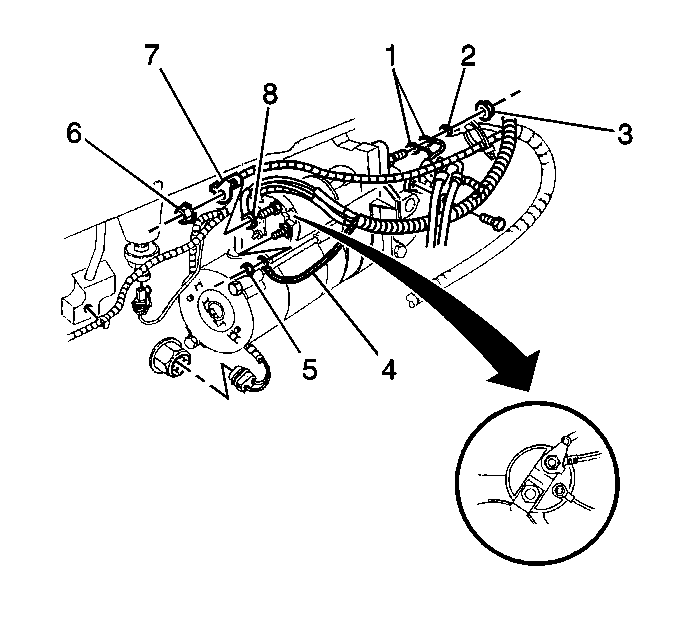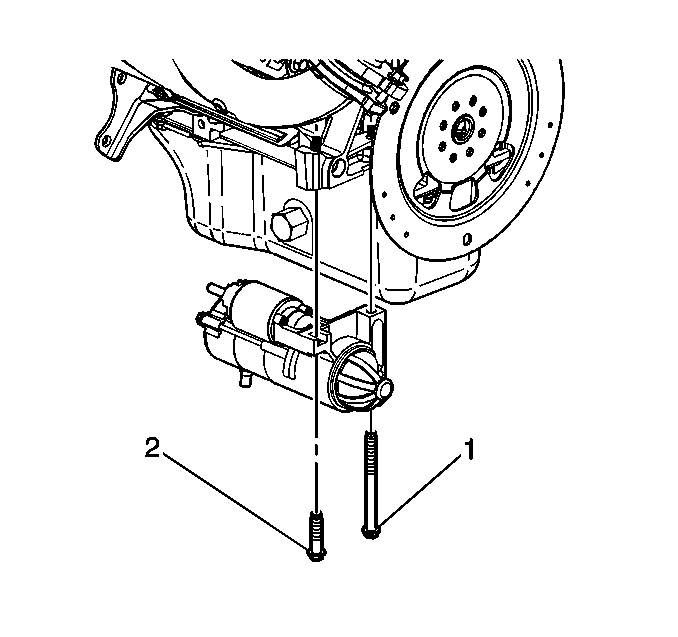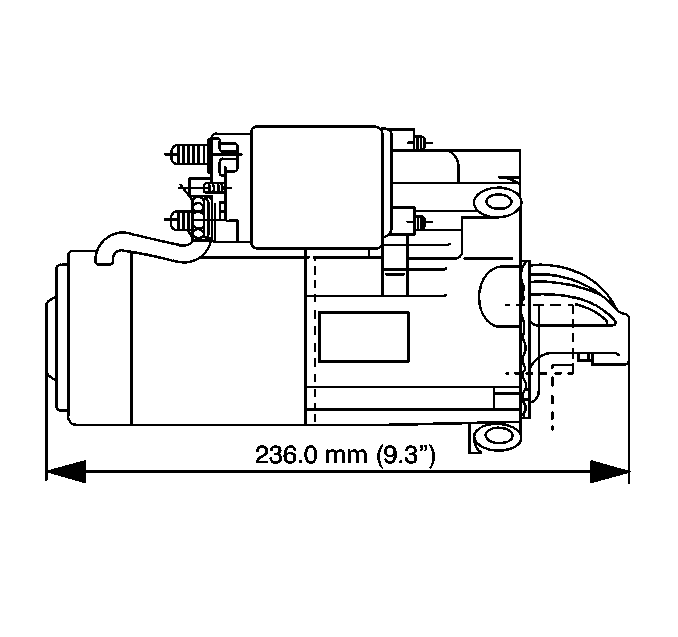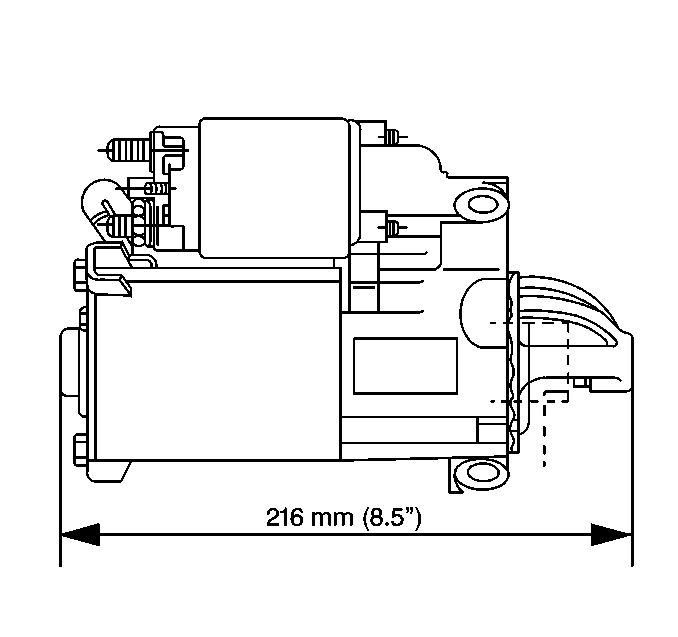Starter Replacement 3.8
Removal Procedure
Important: The starter motor on this vehicle is NOT serviceable and must be replaced as a complete unit.
- Disconnect the negative battery negative cable. Refer to Battery Negative Cable Disconnection and Connection .
- Raise and support the vehicle. Refer to Lifting and Jacking the Vehicle in General Information.
- Remove the lower air deflector. Refer to Radiator Air Baffle Assemblies and Deflectors in Engine Cooling.
- Remove the torque converter covers. Refer to Torque Converter Cover Replacement in Automatic Transaxle - 4T65-E.
- Remove the starter solenoid BAT terminal nut (6) and the positive battery cable (7) from the starter motor.
- Remove the starter solenoid S terminal nut (5) and the starter solenoid wire (4) from the starter motor.
- Remove the starter bolts (1,2) and the starter motor. Remove the shims, if equipped.
Caution: Before servicing any electrical component, the ignition and start switch must be in the OFF or LOCK position and all electrical loads must be OFF, unless instructed otherwise in these procedures. If a tool or equipment could easily come in contact with a live exposed electrical terminal, also disconnect the negative battery cable. Failure to follow these precautions may cause personal injury and/or damage to the vehicle or its components.


Installation Procedure
- The 3.8L uses a PG260 F2 starter motor.
- Align the starter motor to the engine. Install any shims , if removed.
- Install the starter bolts (1,2) finger tight until seated.
- Install the positive battery cable (7) and the solenoid BAT terminal nut (6) finger tight to the starter motor.
- Install the torque converter covers. Refer to Torque Converter Cover Replacement in Automatic Transaxle - 4T65-E.
- Install the lower air deflector. Refer to Radiator Air Baffle Assemblies and Deflectors in Engine Cooling.
- Lower the vehicle.
- Connect the negative battery cable. Refer to Battery Negative Cable Disconnection and Connection .

Verify the correct starter motor is being installed.

Notice: Use the correct fastener in the correct location. Replacement fasteners must be the correct part number for that application. Fasteners requiring replacement or fasteners requiring the use of thread locking compound or sealant are identified in the service procedure. Do not use paints, lubricants, or corrosion inhibitors on fasteners or fastener joint surfaces unless specified. These coatings affect fastener torque and joint clamping force and may damage the fastener. Use the correct tightening sequence and specifications when installing fasteners in order to avoid damage to parts and systems.
Tighten
Tighten the starter bolts (1,2) to 43 N·m (32 lb ft).

Install the starter solenoid wire (4) and the starter solenoid S terminal nut (5) finger tight to the starter motor.
Tighten
| • | Tighten the solenoid BAT terminal nut (6) to 10 N·m (89 lb in). |
| • | Tighten the starter solenoid S terminal nut (5) to 2.3 N·m (20.5 lb in). |
Starter Replacement 3.4
Removal Procedure
Important: The starter motor PG260 F1 on this vehicle is NOT serviceable and must be replaced as a complete unit.
- Disconnect the negative battery cable. Refer to Battery Negative Cable Disconnection and Connection .
- Raise and support the vehicle. Refer to Lifting and Jacking the Vehicle in General Information.
- Remove the lower air deflector. Refer to Radiator Air Baffle Assemblies and Deflectors in Engine Cooling.
- Remove the torque converter covers. Refer to Torque Converter Cover Replacement in Automatic Transaxle - 4T65-E.
- Remove the starter solenoid BAT terminal nut (8) and the positive battery cable (9) from the starter motor.
- Remove the starter solenoid S terminal nut (7) and the starter solenoid wire (6) from the starter motor.
- Remove the starter bolts (1,2) and the starter motor. Remove the shims, if necessary.
Caution: Before servicing any electrical component, the ignition and start switch must be in the OFF or LOCK position and all electrical loads must be OFF, unless instructed otherwise in these procedures. If a tool or equipment could easily come in contact with a live exposed electrical terminal, also disconnect the negative battery cable. Failure to follow these precautions may cause personal injury and/or damage to the vehicle or its components.


Installation Procedure
- The 3.4L uses a PG260 F1 starter motor.
- Align the starter motor to the engine. Install any shims , if removed.
- Install the starter bolts (1,2) finger tight until seated.
- Install the positive battery cable (9) and the solenoid BAT terminal nut (8) finger tight to the starter motor.
- Install the torque converter covers. Refer to Torque Converter Cover Replacement in Automatic Transaxle - 4T65-E.
- Install the lower air deflector. Refer to Radiator Air Baffle Assemblies and Deflectors in Engine Cooling.
- Lower the vehicle.
- Connect the negative battery cable. Refer to Battery Negative Cable Disconnection and Connection .

Make sure the correct starter motor is being installed.

Notice: Use the correct fastener in the correct location. Replacement fasteners must be the correct part number for that application. Fasteners requiring replacement or fasteners requiring the use of thread locking compound or sealant are identified in the service procedure. Do not use paints, lubricants, or corrosion inhibitors on fasteners or fastener joint surfaces unless specified. These coatings affect fastener torque and joint clamping force and may damage the fastener. Use the correct tightening sequence and specifications when installing fasteners in order to avoid damage to parts and systems.
Tighten
Tighten the starter bolts (1,2) to 43 N·m (32 lb ft).

Install the starter solenoid wire (6) and the starter solenoid S terminal nut (7) finger tight to the starter motor.
Tighten
| • | Tighten the solenoid BAT terminal nut (8) to 10 N·m (89 lb in). |
| • | Tighten the starter solenoid S terminal nut (7) to 2.3 N·m (20.5 lb in). |
